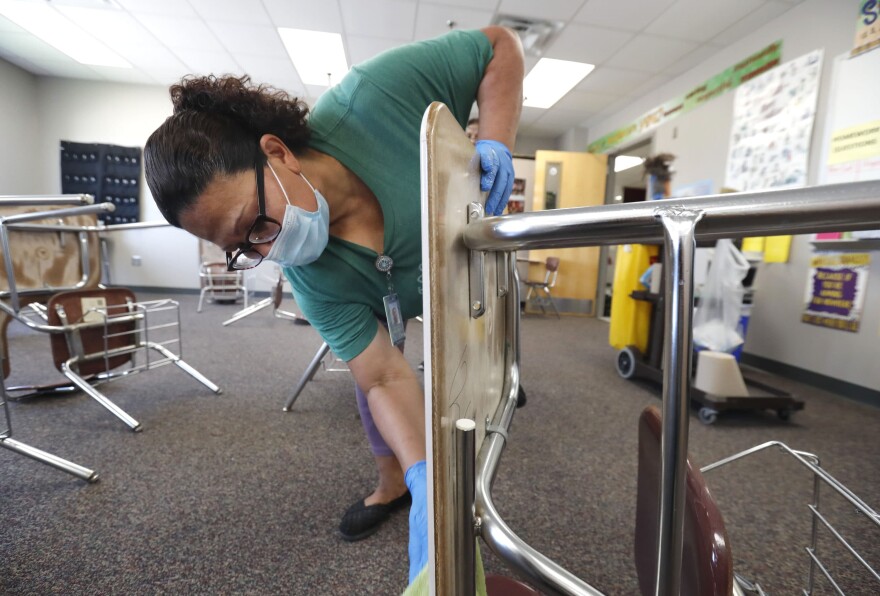One week from Monday, all Iowa school districts will once again offer the option of fully in-person instruction, under a new mandate signed into law by Gov. Kim Reynolds, mandating that schools give parents the choice of face-to-face teaching, even as the state lags behind much of the rest of the nation in vaccinating its residents.
Some schools have been offering the option of face-to-face teaching throughout the pandemic, while others have had families choose between a fully online experience and a hybrid one. Still, some of the state’s largest districts haven’t offered fully in-person instruction since last March. Next week, that will change.
The Dubuque Community School District is preparing for upwards of 80 percent of students to return to the classroom, according to superintendent Stan Rheingans.
“We’ll be somewhere in the 15 to 20 percent who are fully online and then the 85 percent range who will be back with us fully in attendance,” Rheingans said.
The sheer number of students opting for in-person instruction may force the district to reassign some students to new teachers, in an effort to balance class sizes and allow those with medical vulnerabilities to continue teaching virtually.
“The only way to make those numbers work is to pull some kids out of each classroom,” Rheingans said. “So we are letting families know that that’s a possibility. And you know generally kids are pretty flexible with that but it does create a little bit of a disruption, at least for a week or two as they settle into a new classroom.”
One misconception is that 100% in-person can be safely distanced. But with many teachers teaching online, there are fewer in-person teachers. Thus, classes will operate at 100% capacity and will not be safely distanced. If possible, choose online until cases low in your community https://t.co/p2dclssp8a
— Eli Perencevich, MD MS🧼 😷 (@eliowa) February 1, 2021
Even with these efforts, Rheingans and other administrators are worried that depending on how many students return, proper social distancing won’t be possible.
“We’ve created sort of bubbles if you will at the front of classrooms so that the teachers, until they’re fully vaccinated, will have some space between them and the students,” Rheingans said. “But the students themselves will be…oh…depending upon the building, in some cases we can do a 4-foot distance. In some buildings it’s going to be 2 or 3 feet.”
According to a recent study of reopened classrooms by scientists at the Centers for Disease Control and Prevention, there is “little evidence that schools have contributed meaningfully to increased community transmission”. But the study authors warned that “all recommended mitigation measures in schools must continue”, such as requiring universal use of masks, increasing social distancing, and limiting the number of people in classrooms and common areas.
The transition to the in-person option comes after three cases of the U.K. variant of the coronavirus were identified in Iowa, a strain of the virus that “spreads more easily and quickly than other variants”, according to the CDC.
Gov. Kim Reynolds said yesterday Iowa has some of the lowest vaccine allocation and administration rates in the country.
— Natalie Krebs (@natalie_krebs) February 5, 2021
I spoke to rural health departments about what the phase 1B rollout has looked like for them. https://t.co/V47co6vMgT
As more of the state’s students return to the classroom, many teachers, janitors, bus drivers and other school staff continue to struggle to get vaccinated. According to an analysis by the New York Times, Iowa lags almost every other state in the country in distributing the life-saving shots.
Advocates are concerned about the prospect of significantly increasing social contact without a guarantee of proper precautions or the protection of vaccines. Teamsters Local 238, which represents school bus drivers in the Iowa City Community School District, issued a statement urging families to consider ways to get their kids to class without relying on school buses if they’re able, to limit exposure to bus drivers.
“We think it’s a reckless decision on the part of lawmakers. We’re sounding the alarm to remind parents in the District that just because buses are running doesn’t mean it’s the best option for transportation. A fewer number of students on each bus is going to be the safest bet,” Chief Union Steward Dan Ramsey said in a written statement. “If you can drive your kids – do it.”
Iowa Gov. Kim Reynolds has eliminated most of the state's COVID-19 restrictions, including mask requirements in public places and caps on indoor and outdoor gatherings.https://t.co/JVaOyjCaMt
— NPR (@NPR) February 6, 2021
While the risks of increased transmission are clear, so are the educational, social and emotional impacts that remote learning has had on students. For kids experiencing homelessness, food insecurity, loneliness and mental illness, getting back in the classroom offers a chance for reconnection and access to critical resources.
“Everybody wants everybody to be in school, face to face, full time,” said Roark Horn, Executive Director of School Administrators of Iowa. “We all start with that foundational belief that kids are best served if they’re face to face with excellent teachers in their classrooms.”
Rheingans in Dubuque says his district will be closely monitoring any transmission of the virus as more students return to the classroom, in order to assess whether the face to face model remains safe and sustainable.
"We're nervous," he said, "but we're also working hard to make it happen."






